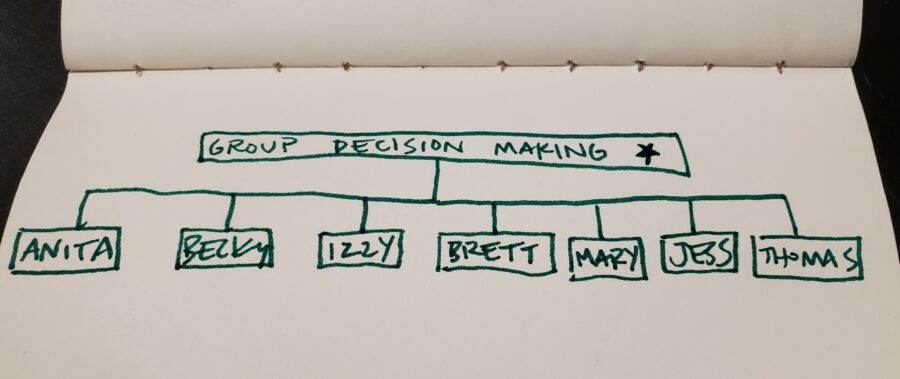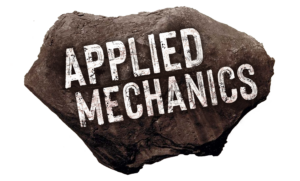
While the primary, public facing elements of Applied Mechanics are the creative art we make (and you perhaps have seen), behind the scenes there is a vital, non-hierarchical administrative structure which we co-create.
Applied Mechanics makes art and manages this art as a collaborative- where our seven company members share all the leadership, executive, and administrative tasks and decisions.
Applied Mechanics has taken this form from its beginnings, (in 2009) spearheaded by leadership work our artistic director Becky Wright gained through teaching at the New England Literature Program (NELP). NELP is an educational program focusing on the writing of transcendentalists, abolitionists, meditative poets, etc. and the program requires participants to also rotate work responsibilities including preparing meals, washing dishes, and cleaning common areas.
Communication is key.
Applied Mechanics is interested in a broad sharing of knowledge and understanding of our organizational activities for everyone in the company. With our work, there are no passive participants and everyone’s labor is equitably supporting the day to day of the company. Labor must be shared in order to survive as we each have limited capacity. American capitalism sacrifices humanness, deprioritizes rest, and commodifies relationships, while we are doing something different. We prioritize the personal needs of the company members and navigate these ongoing changes and transformations as they arise. Individual health is a value for us as it is integral for us to also be healthy as a company.
With our non-hierarchical structure Applied Mechanics’ company members collectively make the final decisions AND together complete all the tasks. Once decisions are made we then form the next steps and delegate what is needed between us.
The details:
We have created a 20+ page systems document (bylaws) detailing who we are and how we work. Every summer we have a retreat (The Jamboree!) to reevaluate these systems and edit the realities of our work. These bylaws include information about our benefits as members, expectations as company members, and what each of our jobs entail.
We strive to cater to each person’s interests, though there is work that we have to do, even if we may not be excited about it: such as perhaps those annual asks for donations! 😉
We have learned a lot over the years. We started very small and DIY. We are still both these things, but have learned a lot by trying with abandon! One of our artistic prompts is to create disposable art, meaning create without a filter, we also thoughtfully and creatively push toward trying process wholeheartedly with a willingness to fail. One example Applied Mechanics used to offer was a meal at every rehearsal. This was institutionalized early on to meet two purposes: 1) it was valuable for us to share space together as friends/ a community in the middle of an artistic process & 2) we could not afford to pay everyone a decent pay rate, so we offered this as a way to meet a financial need. (Becky is an amazing shopper and cook → who fed an artistic team of 30 people for our TWO runs of Vainglorious!)
By 2016 we were paying everyone a decent wage and still cramming in a meal which at this point became a time suck to our lives. As it takes time to make a meal, company members lost a lot of artistic brain space because they needed to prep and cook a meal for the entire artistic team. We realized for our sanity that we should no longer provide meals. Our artistic brains were getting exhausted by a labor we had created for ourselves. So we changed this standard and language in our bylaws.
(P.S. We do still have a sparkly snack table at (in-person) rehearsals!)
Committee work
As it would be a challenge for each individual’s capacity to oversee everything together we have divided labor into smaller committees. Each of our seven committees has three to four company members.
Our ongoing committees:
- Business Logistics
- Direct Action
- Education for Fun and Profit
- Get Money
- Production logistics
- Public
- Touring
Similar to traditional departments like developmental work and marketing, these committees dig into the granular and specifics of the overarching goals of the company. We evaluate the systems and structures each year at the Jamboree, and these committees shift, as needed, to meet our goals. For example touring and direct action are newer committees. This happened organically at first, and then was formalized later with growing collective interest both in and outside of the company. The Direct Action Committee had been a standing member of PCAC (Philadelphia Coalition of Affordable Communities) for almost five years, taking a formal stand in the fight against gentrification in the city and promoting community-based work, but it was only then, several years later that we realized we needed a committee to keep this ongoing labor running smoothly.
Each committee gets time at our monthly company meetings to cover any announcements and/or offer proposals to the entire team. These guide us toward moments of collective decision making in which we do with do by keeping the health of the company and its members at the fore. And along the way sometimes temporary committees are made too: such as party committee, jamboree, marketing committee, etc. that also organize our labor into manageable chunks.
Decision making can be a slow process.
Getting everyone on the same page can be difficult. We are just seven people and we know, it takes time and effort for everyone to understand what they are saying yes too. Some of this was even more challenging earlier in our company life. We were still learning everyone’s best methods of communication: some people don’t work well over email, some people don’t want to respond to a text. Finding ways for everyone to opt in and support what may not work for a particular human was helpful for us to gain clarity and efficiency. But things are still slow. Big decisions like our collective budgeting of our annual budget takes months of planning, editing, and shuffling. And then to teach everyone what finite language frames each budget line can be daunting. Additionally, following a Quaker method of decision making known as “standing aside” has also been a positive reorienting to decision making. Not everyone has to love an idea brought to the company. However we do have to get at least a “sideways thumb” from everyone that they don’t have blocking concerns over a proposal.
This is a very simplified beginning of how we collaborate. Want to know more? We love sharing process and hope this gives a peek into an alternative to the hierarchical systems that are seemingly ever present. But they don’t have to be! Ask us about how we work.
